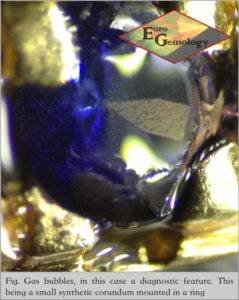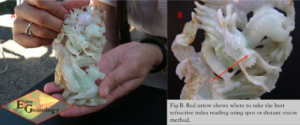 This is the part where gemology becomes really interesting. Every single research procedure will depend on the possible accessibility to the mounted gemstone and in some cases of no access at all, the remaining option is to remove the gemstone for research. In the last case everything will depend on the “possible” value of the “gemstone” as in this stage there is no guarantee of the gemstone being natural, this should be carefully evaluated together with the client/owner.
This is the part where gemology becomes really interesting. Every single research procedure will depend on the possible accessibility to the mounted gemstone and in some cases of no access at all, the remaining option is to remove the gemstone for research. In the last case everything will depend on the “possible” value of the “gemstone” as in this stage there is no guarantee of the gemstone being natural, this should be carefully evaluated together with the client/owner.
The best places to obtain practice would be on auction houses or on gem fairs where visitors can bring their jewelry to be checked (usually this would be a free service, but the gained experience is priceless).
A possible work structure
- Observe the unidentified mounted gemstones with a loupe/hand lens.
- Verify which gemological tests can be executed in order to find diagnostic features.
- Try to find a spot on the mounted gemstone(s) where you can read the refractive index. Use spot reading or distant vision method on star or bezel facets, as the gemstone will not stand by itself. The protrusion of the hemicylinder on the refractometer can play a great role, as a greater protrusion could give the opportunity to get a refractive reading between the prongs. Quite often the table facet is just below the level of the prongs.
- In case of not being able to get refractive index readings, try a Gemmeter or Duo Tester. Any extra information is very important when testing mounted gems.
- The immersion polariscope will reveal it’s great potential as you can really eliminate the reflections. If possible research whether the gemstone is isotropic, uniaxial (+/-) or biaxial. This can take a while, but worth the effort.
- Dichroscope
- Observing the spectrum is very important, especially when dealing with very small mounted gemstone – for example, the spectrum of a ruby can be a diagnostic feature. For this, it’s useful to have a very small fiber optic light source and not to forget a green filter when dealing with red spinel.
- UVL-UVS testing
- A full observation of the mounted gemstone/s on microscope (if possible in immersion), with all possible light sources, filters, etc…
 When dealing with mounted gemstones there is no fix work structure, it can be different every time. Write down your results and observations. Then verify whether there are enough diagnostic features to determine the gemstone, being either natural, synthetic, an artificial product, an imitation or even treated. Be careful when giving a verdict on whether the gemstone had been treated or not as your internal observations are limited due to precious metals or other alloys surrounding the gemstone.
When dealing with mounted gemstones there is no fix work structure, it can be different every time. Write down your results and observations. Then verify whether there are enough diagnostic features to determine the gemstone, being either natural, synthetic, an artificial product, an imitation or even treated. Be careful when giving a verdict on whether the gemstone had been treated or not as your internal observations are limited due to precious metals or other alloys surrounding the gemstone.



















